At a glance
CDC provides disaster epidemiology training and technical assistance to requesting state, tribal, local, territorial health departments, other federal and international agencies, academia, and partner organizations. Subject matter experts are available for consultation and technical assistance throughout the disaster cycle to help minimize the effects of disasters on communities.

Technical assistance
CDC provides consultation and technical assistance during all phases of a disaster cycle (preparedness, response, recovery, and mitigation).
Topic areas include:
- Disaster morbidity and mortality surveillance
- Rapid needs assessments (including the Community Assessment for Public Health Emergency Response)
- Disaster-specific preparedness and response planning
- Advice on epidemiologic studies and research
Subject matter experts from CDC's National Center for Environmental Health also deploy to the field by request. They lead the CDC Emergency Operations Center's Epidemiology and Surveillance Task Force, coordinating the collection and analysis of health surveillance data, during a response.
If you would like remote or in-field consultation or technical assistance, please contact [email protected].
In-person training
CDC provides disaster epidemiology training to state, tribal, local, and territorial (STLT) public health and emergency response staff by request. The purpose of the trainings is to increase emergency response capacity, improve disaster epidemiology skills, and share lessons learned.
Topic areas include the following:
- Public health impacts of disasters and disaster epidemiology overview
- Community Assessment for Public Health Emergency Response (CASPER)
- Disaster morbidity and mortality surveillance
- Emergency radiation preparedness
- Other disaster-related topic areas (by request and subject matter expertise)
If you are a state or local health department and would like to be considered for training, consult with your leadership. You should then contact Amy Helene Schnall (770-488-3422, [email protected]). You may also download a Disaster Epidemiology Training Request form.
Online trainings
Overview of Disaster Epidemiology
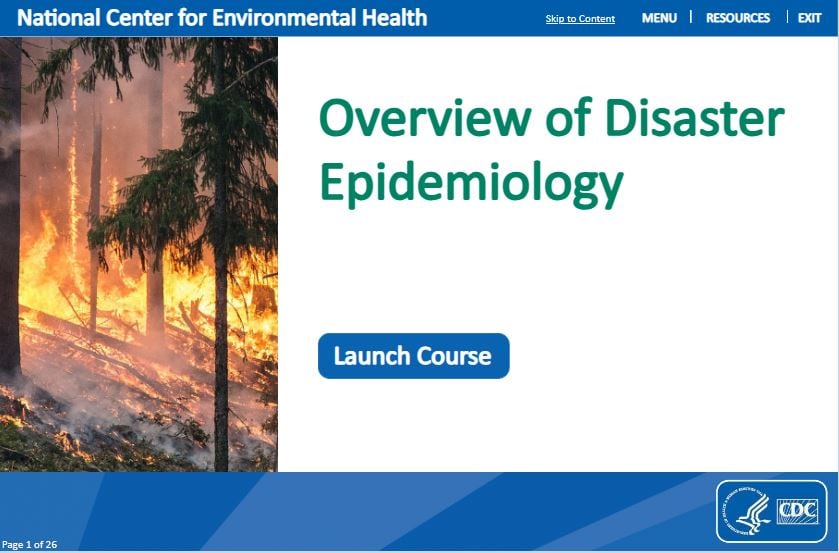
This short eLearning provides an overview of disaster epidemiology including:
- Potential public health impacts of disasters
- Difference between direct and indirect effects of a disaster
- Role of a disaster epidemiologist
Disaster epidemiology eLearning modules
To aid in effective planning for disasters, CDC developed multiple eLearning modules that highlight the public health-related effects of disasters. These modules are designed to help the public health and emergency workforce better prepare for and respond to disasters.
The course is made up of four modules. You may take each in order, or separately as needed.
- Public Health Impact of Disasters
- Public Health Emergency Management
- Community Assessment for Public Health Emergency Response (CASPER)
- Disaster Surveillance
Module 1: Public Health Impact of Disasters
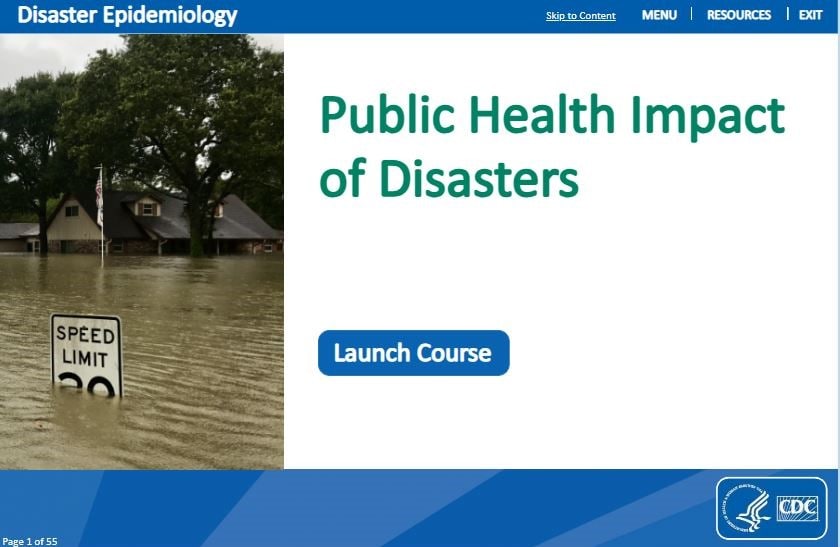
Module 1 reviews the public health impacts of disasters. In this 50-minute module, learners will:
- Review basic concepts about disasters
- Look at the direct and indirect impact of disasters on public health in different types of communities
- Discuss how and why certain populations are disproportionately vulnerable to these impacts
Module 2: Public Health Emergency Management
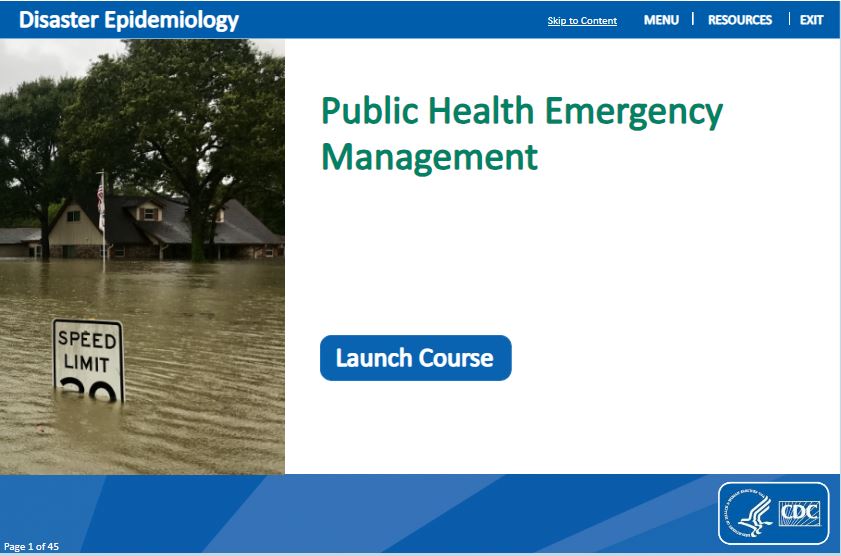
Module 2 reviews public health emergency management. This 45-minute module provides learners with a summary of public health emergency management and planning for a disaster response and recovery. After completing this module, learners will be able to:
- Describe the role and function of public health agencies in a disaster
- List the implications of the relevant federal laws and authorities related to public health's role in a disaster
- Identify the major components of the national incident management system
- Define various positions within an incident command system
- List components of an emergency response plan for public health
Module 3: Community Assessment for Public Health Emergency Response (CASPER)
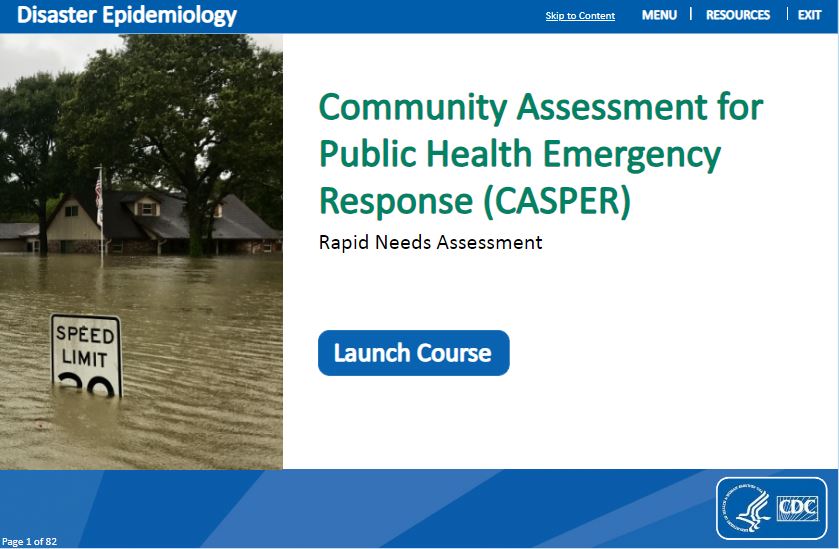
Module 3 is dedicated to the Community Assessment for Public Health Emergency Response (CASPER). In this 75-minute module, learners will review:
- The CASPER methodology
- When to conduct a CASPER
- How to implement a CASPER, including basic data analysis and interpretation
Module 4: Disaster Surveillance
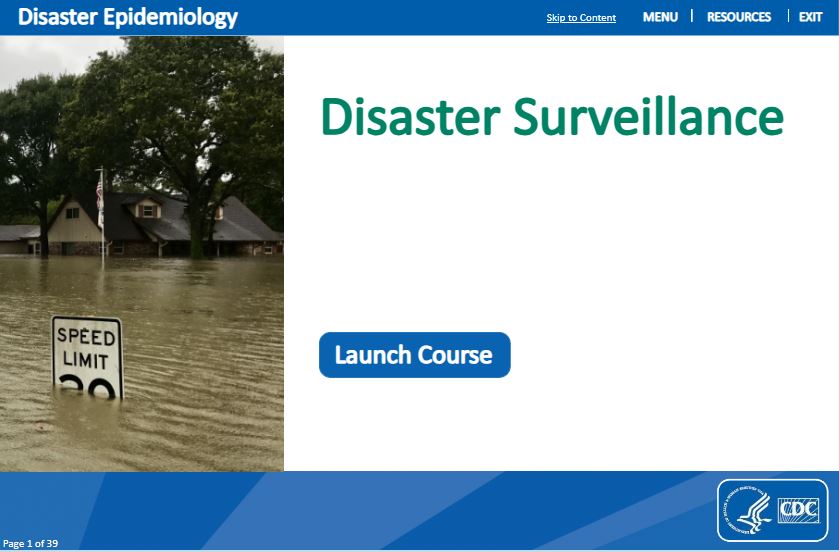
Module 4 covers disaster morbidity and mortality surveillance. In this 40-minute module, learners will review:
- Why disaster surveillance is important
- The purpose of morbidity and mortality surveillance during a response
- The tools to assist in disaster surveillance
Guidance for Certification of Deaths in the Event of a Natural, Human-Induced, or Radiological/Chemical Disaster
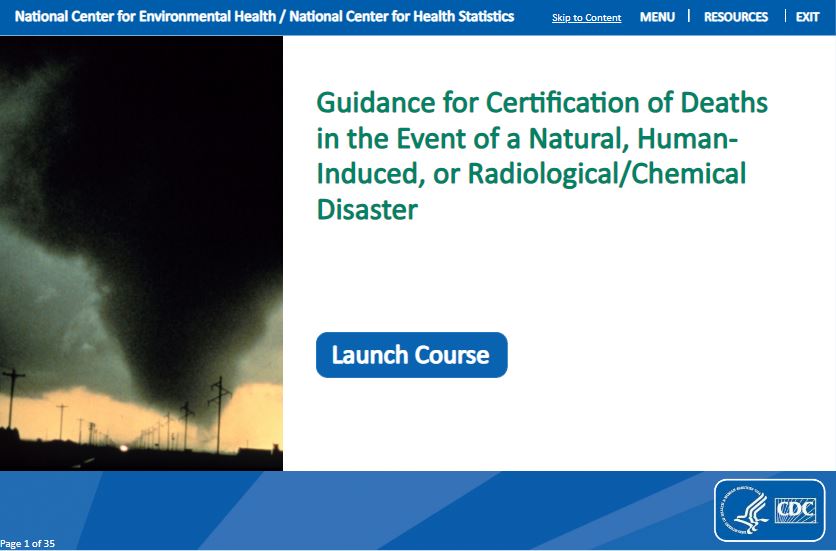
This 30-minute eLearning training provides death certification guidance for medical examiners, coroners and physicians. After completing this course, learners will be able to:
- Describe the importance of accurate death certification for disaster-related mortality surveillance
- Identify a disaster-related death
- Explain how to complete the death certificate for a disaster-related death
Death Scene Investigation After Natural Disaster or Other Weather-Related Events Toolkit Training
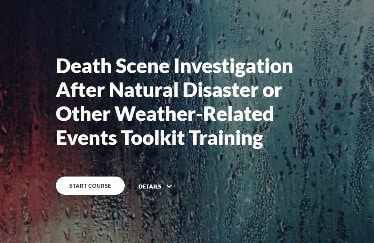
This online training aims to familiarize learners with CDC's Death Scene Investigation after Natural Disaster or Other Weather-Related Events Toolkit.
After completing the course, learners will be able to:
- Define the term, "disaster", as it relates to death scene investigation after natural disasters or other weather-related events
- Define the importance of collecting accurate mortality data, as it relates to vital statistics records for natural disasters or other weather-related events
- Describe three tools within the Death Scene Investigation after Natural Disaster or Other Weather-Related Events Toolkit
- Identify three supplemental forms within the Death Scene Investigation after Natural Disaster or Other Weather-Related Events Toolkit
